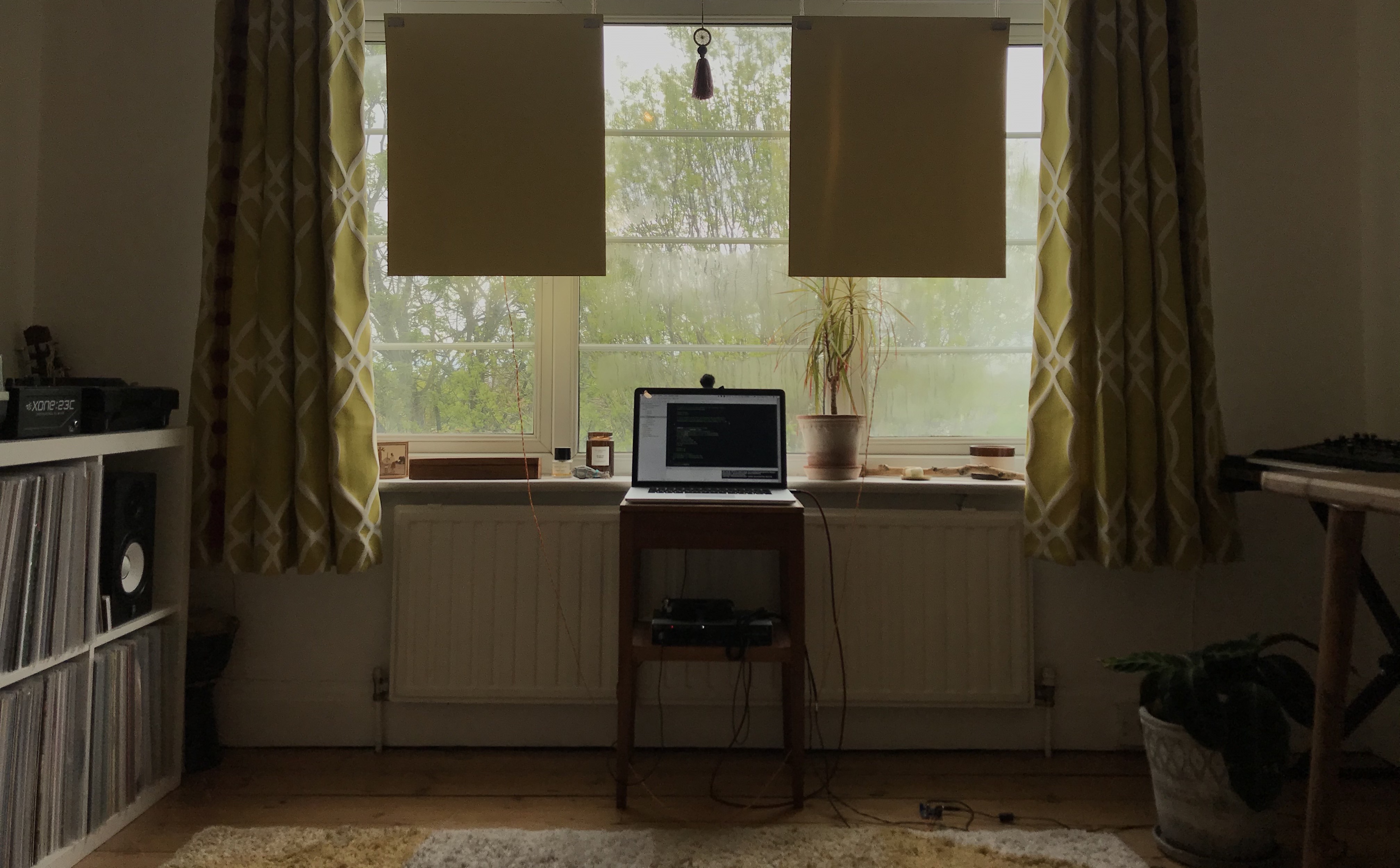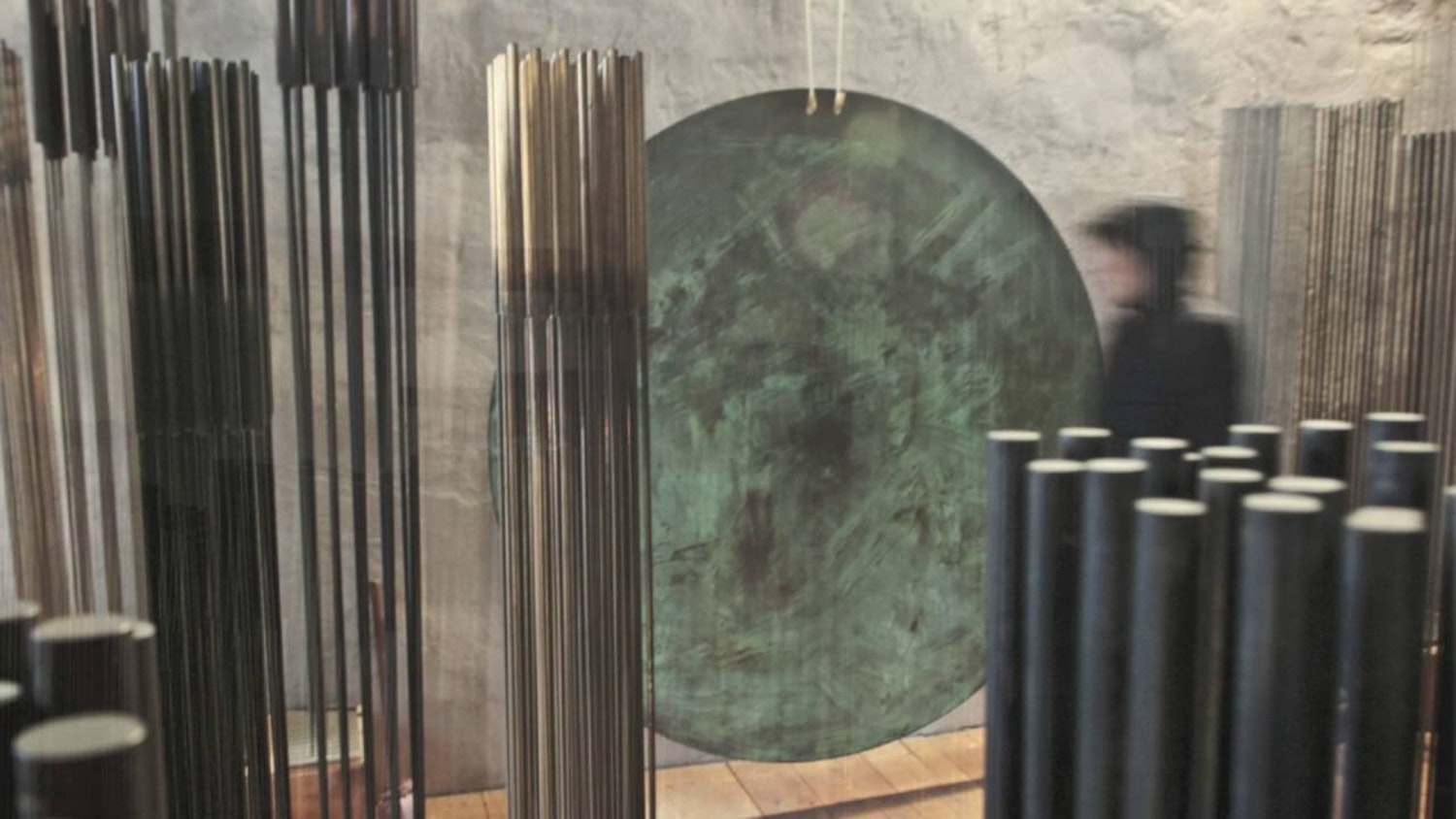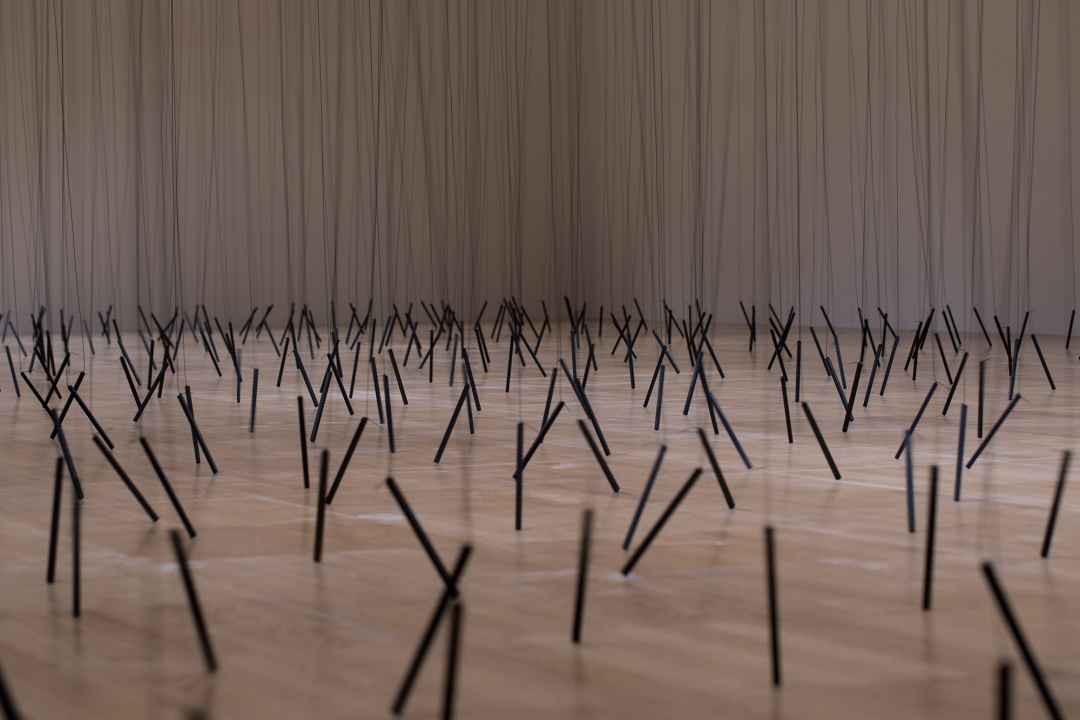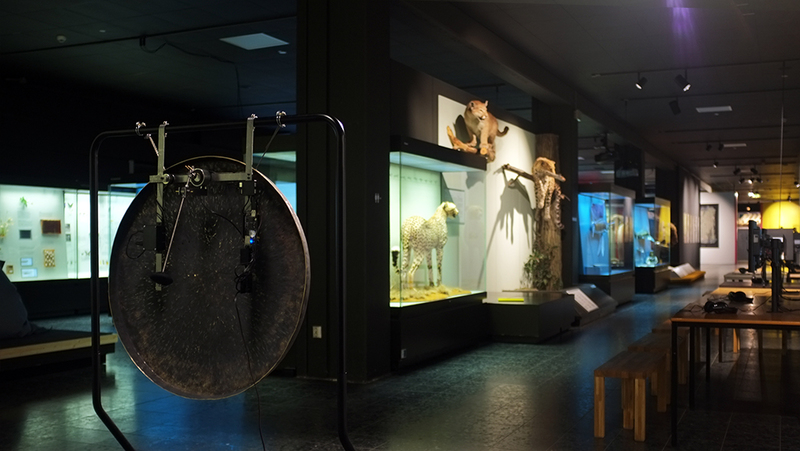

The Life of Metal
Interactive sound installation inspired by Jane Bennett's book Vibrant Matter: the political ecology of things, in particular, a chapter named 'The Life of Metal'.
produced by: Lucie Štěpánková
Introduction
"I try to bear witness to the vital materialities that flow through and around us." J. Bennett
'The Life of Metal' is an interactive sound installation where participants interact with two sheets of brass to create stochastic soundscapes. This work re-imagines a chapter of the same name from Jane Bennett's new materialist book Vibrant Matter. In the book, Bennett conceptualizes the inner vibrancy of inanimate matter through the lens of philosophy and political theory with a particular focus on metals in my chosen chapter. The participant's movements in the exhibition space are captured by a webcam and processed in OpenFrameworks. The data flow is analysed through a computer vision engine using ofxOpenCV and sonified through a sinewave synthesis patch using ofxMaxim to produce resonant sounds with surface transducers attached to the back of the metal sheets. The resulting soundscape is a loose re-interpretation of the participant's presence in the space, their movements and interactions with the installation. The produced sounds are not expected to not mirror these interactions, rather they created in a semi-random fashion. This approach is in line with the mysterious nature of the inner vibrancy of matter (or thing-power - "the curious ability of inanimate things to animate, to act, to produce effects dramatic and subtle" J. Bennett (p. 6)) which, as a rule, is inaccessible to human understanding and therefore cannot be designed accurately. This giving up of control over the final outcome does not necessarily produce the most favorable and pleasant sounds to the human participant but it more faithfully represents the enigmatic nature of the matter which speaks to us in tongues.
Concept and background research
"Why advocate the vitality of matter? Because my hunch is that the image of dead or thoroughly instrumentalized matter feeds human hubris and our earth-destroying fantasies of conquest and consumption." J. Bennett
'The Life of Metal' is a title borrowed from the aforementioned chapter exploring the vitality of metals in Bennett's Vibrant Matter. Importantly, thorough the book Bennett turns to writings of the Dutch philosopher Baruch Spinoza who claims that all things "are animate, albeit in different degrees" (Bennett, 2010, p.5), French phenomenologist Maurice Merleau-Ponty who believes that experience of our own body will allow us to "discover in all other 'objects' the miracle of expression" (ibid.) and French philosopher Giles Deleuze who champions the notion of immanence, an indwelling presence of aliveness in things.
The idea behind 'The Life of Metal' is to raise awareness of the concept of the immanent vitality of matter Bennett explores and to transform it into a lived experience that can hopefully impact the way in which we experience and interact with the world around us. I strongly agree with Bennett's above quote and believe that the way in which we regard and interact with things needs to be more apprehensive of the thing-power they possess yet is not always available to our perception as - in many cases - it exists at different time-space scales.
In terms of artworks, I was inspired by Harry Bertoia's Sonambient sound sculptures, Julian Oliver's conceptual work The Extinction Gong, the prepared DC-motor-powered installations of Zimoun and Brian House's Animas - an installation piece sonifying river pollution using metal sheets. The reason for choosing metal as the material of choice was based on its resonant qualities lending themselves well to sonic applications.
Technical / Self-evaluation
The installation's audible outcome comes from a pair of surface transducers (vibrational speakers) resonating two hanged brass metal sheets with one speaker per sheet attached discretely at the back. The sounds are generated through a simple sinewave synthesizer receiving real-time two-dimensional coordinates from a computer vision algorithm. The choice to use sinewaves was made deliberately to ensure that the resulting resonances are as neutral as possible. By using sinewaves the resonances of the metal sheets are not additionally coloured by the timbral complexity of more intricate waves such as sawtooth - which is usually used as a starting point in synthesizing brass instruments but does not serve the purpose here.
The root of this installation system is an OpenFrameworks app using ofxOpenCV and ofxMaxim addons. Live webcam feed is analyzed in real-time and fed into a contour finder locating pixel blobs between a set pixel-count range. The blob positions are averaged and the centroid of all available blobs is calculated and updated each frame to generate a live-data stream of x and y coordinates. These coordinates are fed into the synthesizer class and assigned to modulate two frequencies which are then sent via a 3.5mm jack cable into an Arduino amplifier and finally into the two transducers.
Given the limited access to resources and lack of inspiration due to the current situation, I am happy with how the work turned out. Undeniably, this piece is designed to be experienced in person and so parts of the documentation process were fairly difficult. In particular, the sounds of the metal resonances proved impossible to be captured accurately due to their rich timbral content. I tried several approaches and finally decided to use a close mic technique, using high-sensitivity super-directional condenser mic. Despite all this, I believe that the concept is felt strongly through the work and that it manages to be fairly engaging despite offering a non-linear approach to interaction. I approached this project as a prototype for a much larger piece using the same materials and systems. This work would only be possible to produce with a considerable budget and more appropriate work and exhibition space.
Further development
"The hope is that the story will enhance receptivity to the impersonal life that surrounds us and infuses us, will generate a more subtle awareness of the complicated web of dissonant connections between bodies, and will enable wiser interventions into that ecology" J. Bennett
I feel that the installation would benefit from a larger and more resonant space and more sound sources to be able to facilitate full immersion and offer complex spatial interactions where the participants would work with space as an - additional - instrument. If realised in a gallery space, the presence and motion of the participants would be captured by a high-resolution camera and the app would be running independently on a Bela board - both discreetly placed out of sight of the audience. In an ideal scenario, I would work with metals of various thicknesses and textures to explore the nuances of these differences in terms of sound. In an appropriate exhibition space, I would also add a visual element in form of light that would cast reflections on and from the metallic surfaces - reflections that would flutter as the sheets vibrate. I believe that adding this simple visual element would make the experience more engaging to the wider public. Extending the point of entry into the work from only sonic to (also) visual may ease the less sonically inclined participants into the work. This visual aid would not be designed to take over the sonic element of the work but would rather be used as a tool for engagement and prolonging the audiences' attention span.
Reference List
Bennett, J. (2010). Vibrant matter: a political ecology of things. Durham: Duke University Press.
Bertoia, H. (n.d.). Sonambient. [Sound installation / Sound sculpture].
Deleuze, G. (1997). Immanence: a life. Theory, Culture & Society, 14(2), pp.3–7.
House, B. (2017). Animas. [Mixed media installation].
Merleau-Ponty, M. and Smith, C. (2015). Phenomenology of perception. London: Forgotten Books.
Oliver, J. (2017). The Extinction Gong.
Spinoza, B.D. (1996). Ethics. London ; New York: Penguin Books.
Code References
Title: ofxCvContourFinder
Availability: <https://openframeworks.cc/documentation/ofxOpenCv/ofxCvContourFinder/>
Title: particlesExample
ADDONS USED:
ofxMaxim - Available at: https://github.com/falcon4ever/ofxMaxim
ofxOpenCV - Available at: https://github.com/openframeworks/openFrameworks/tree/master/addons/ofxOpenCv
The images below are from artworks by Harry Bertoia, Zimoun, Brian House and Julian Oliver







































































